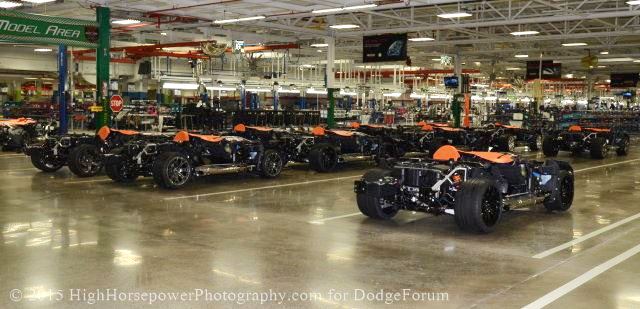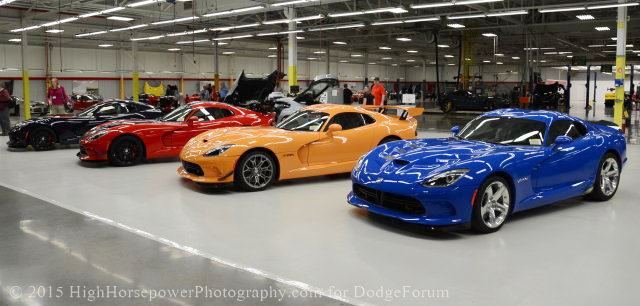A Look at Dodge Viper Production
Last week, I had a chance to visit Chrysler’s Conner Avenue Assembly Plant where every new Dodge Viper is built. After a short presentation for the new 2016 Viper ACR, we got to tour the plant and see each step of the process that takes the meanest of the American supercars from a bare chassis to a 645 horsepower beast built to beat the best in the world.
The Dodge Viper is legitimately built from hand and while some companies claim that a car is built by hand, many of those vehicles have robots that perform key tasks along the way. On the other hand, the Viper is literally put together piece by piece, all by hand. The only robots that you will find in the Conner Ave plant is one station where robots measure all of the dimensions of the chassis to ensure that it is perfect prior to production and the second scans the final product to make sure that the body gaps are all correct.
Other than those two areas, each stop in the Viper’s production process is performed by members of a highly skilled, carefully selected team of the best car builders in the country. This team of just over 60 people is responsible for every aspect of Viper production, including assembling the 8.4L V10 and these folks take extreme pride in turning out the ultimate American supercar. The only downfall to the true hand-building process is that it is more time consuming than the heavily robot-aided processes of most other vehicles. As a result, Conner Ave turns out just three Vipers each day, so we couldn’t follow a car from beginning to end, but we got to see most of the key stations with cars being prepared.
The basic production process of the Dodge Viper begins with a bare chassis and the first items to be added are the dash/instrument panel, the wiring and the rear differential.
Next, the crew adds the engine and transmission to the Viper, completing the drivetrain before bolting up the entire suspension and steering system, including the high performance Brembo brakes. During this portion of the production process, the Viper also gets the radiator, the fuel tank and all of the fluids. Before getting the wheels, each Viper is given a proper alignment and after the wheels are fitted up, every single Viper goes into a roller room where the car is driven up to 90 miles per hour – giving the driver a chance to make sure that the transmission shifts correctly, the engine starts, runs and revs as it should, that the steering system works and that the brakes bring the car down from this simulated speed.
After that, each Viper goes to a staging area to wait for the body and the rest of the interior. At that point, the Viper is like a 645-horsepower go kart, and even without the skin, this American supercar looks menacing.
After the Viper has time to cool down from its test run on the rollers, each car hits the second half of the assembly line. The inner portion of the trunk, the rollover safety bar and the race-ready bucket seats are bolted up before the body panels themselves are added – starting with the roof, the rear hatch, the rear quarter panels and the rear fascia. From there, the doors, the hood, the headlights, the side skirts and the front fascia are carefully added to complete the exterior build.
At that point, the Dodge Viper is officially assembled, but each car then goes through a series of tests including a high-pressure water chamber test, a suspension test where a series of pistons apply pressure to each wheel individually, and a final area where a series of robotic arms measure all of the body panel gaps.
Finally, each new Dodge Viper is visually inspected, cleaned and polished before being shipped to the dealership, with random cars chosen throughout the day and sent to the audit area where every aspect of the vehicle is scrutinized.
The images below show the various points in the production process, beginning with the bare chassis and ending up with the finished products waiting to be shipped to the new owner.

































